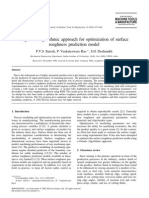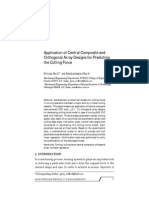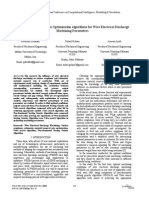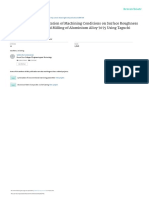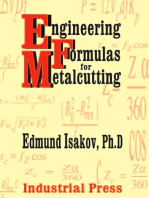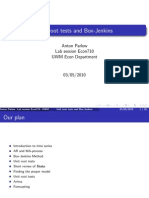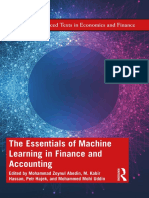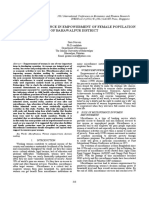Determination and Optimization of Cylindrical Grinding Process Parameters Using Taguchi Method and Regression Analysis
Determination and Optimization of Cylindrical Grinding Process Parameters Using Taguchi Method and Regression Analysis
Uploaded by
haiheeeCopyright:
Available Formats
Determination and Optimization of Cylindrical Grinding Process Parameters Using Taguchi Method and Regression Analysis
Determination and Optimization of Cylindrical Grinding Process Parameters Using Taguchi Method and Regression Analysis
Uploaded by
haiheeeOriginal Description:
Original Title
Copyright
Available Formats
Share this document
Did you find this document useful?
Is this content inappropriate?
Copyright:
Available Formats
Determination and Optimization of Cylindrical Grinding Process Parameters Using Taguchi Method and Regression Analysis
Determination and Optimization of Cylindrical Grinding Process Parameters Using Taguchi Method and Regression Analysis
Uploaded by
haiheeeCopyright:
Available Formats
M.Janardhan et al.
/ International Journal of Engineering Science and Technology (IJEST)
DETERMINATION AND
OPTIMIZATION OF CYLINDRICAL
GRINDING PROCESS PARAMETERS
USING TAGUCHI METHOD AND
REGRESSION ANALYSIS
M.Janardhan1 and Dr.A.Gopala Krishna2
1
Professor, AbdulKalam Institute of Tech. Sciences, Vepalagadda, Kothagudem, Khammam Dist.AP., India
2
Associate Professor, Department of Mechanical Engg, JNTU College of Engg, Kakinada.AP., India
E mail:jc_muppala@yahoomail.com
Mobile:9849497834
ABSTRACT
Cylindrical grinding is one of the important metal cutting processes used extensively in the finishing operations.
Metal removal rate and surface finish are the important out put responses in the production with respect to
quantity and quality respectively. The Experiments are conducted on CNC cylindrical grinding machine with
L9 Orthogonal array with input machining variables as work speed, feed rate and depth of cut. Empirical
models are developed using design of experiments and response surface methodology. The adequacy of the
developed model is tested with ANNOVA. The developed model can be used by the different manufacturing firms
to select right combination of machining parameters to achieve an optimal metal removal rate (MRR) and
surface roughness (Ra).The results reveals that feed rate, depth of cut are influences predominantly on
the output responses metal removal rate (MRR) and surface roughness (Ra).The predicted optimal values
for MRR, Ra for Cylindrical grinding process are 62.05 gm/min and 0.816 m respectively. The results are
further confirmed by conducting confirmation experiments.
Key Words:
Cylindrical grinding, Metal removal rate (MRR), Surface roughness (Ra),
Design of experiments (DOE), Taguchi method and regression analysis
I Introduction
Cylindrical grinding is an essential process for final machining of components requiring smooth surfaces and
precise tolerances. As compared with other machining processes, grindings costly operation that should be
utilized under optimal conditions. Although widely used in industry, grinding remains perhaps the least
understood of all machining processes. The major operating input parameters that influence the output
responses, metal removal rate, surface roughness, surface damage, and tool wear, etc. are (i) wheel parameters:
abrasives, grain size, grade, structure, binder, shape and dimension, etc. (ii) Work piece parameters: fracture
mode, mechanical properties and chemical composition, etc. (iii) Process parameters: work speed, depth of cut,
feed rate, dressing condition, etc. (IV) machine parameters: static and dynamic Characteristics, spindle system,
and table system, etc. The present paper takes the following input processes parameters namely Work speed,
feed rate and depth of cut. The main objective of this paper is to show how our knowledge on grinding process
can be utilized to predict the grinding behavior and achieve optimal operating processes parameters. The
knowledge is mainly in the form of physical and empirical models which describe various aspects of grinding
process. A software package has been developed which integrates these various models to simulate what
happens during cylindrical grinding processes. Predictions from this simulation are further analyzed by
calibration with actual data. It involves several variables such as depth of cut, work speed, feed rate, grit size,
type of abrasive, chemical composition of wheel, etc. The main objective in any machining process is to
ISSN : 0975-5462
Vol. 3 No. 7 July 2011
5659
M.Janardhan et al. / International Journal of Engineering Science and Technology (IJEST)
maximize the metal removal rate (MRR) and to minimize the surface roughness (Ra).In order to optimize these
values taguchi method, ANNOVA and regression analysis is used.
2. Taguchi Method and Regression analysis
Taguchi method is the process of engineering optimization in a three step approach namely system design,
parameter design and tolerance design. In the system design, a basic functional prototype design will be
produced by applying scientific and engineering knowledge. In parameter design, independent process
parameter values will be optimized and where as in tolerance design, tolerances will be determined and analyzed
for optimal values set by parameter design. Taguchi method is a powerful design of experiments (DOE) tool for
optimization of engineering processes, in which the concept of S/N ratio is used for the improvement of quality
through variability reduction and improvement of measurement. The transformation of the repetition data to
another value, which is a measure of the variation and at least two data points are required to determine the S/N
ratio. There are several type of S/N ratios are available based on the characteristic namely lower is
better(LB),nominal is the best(NB),higher is better(HB) and mathematical equations of these S/N ratios is
expressed in equations (1),(2)and (3).The optimal level of the process parameters is the level with highest S/N
ratio. A statistical analysis of variance (ANNOVA) is performed to determine the significant process
parameters.
Lower is better S/N =-10 log [1/n (yi2)] ---- Eq. (1).
Higher is better S/N =-10 log [1/n (1/yi2)] ---- Eq. (2).
Nominal is better S/N =10 log [y/Sy2] ---- Eq. (3).
Where n is the number of observations, y is the observed data, Sy2 is the variance of y.
The orthogonal array is selected for the process parameters based on the Taguchi method the total degrees of
freedom for three levels with three process parameters were six. The L9 Orthogonal array with nine
experimental readings and three levels was selected for the Present work. The process parameters and their
levels in this study are presented in the Table 1.
Regression analysis is used to determine the relationships of the variables which influences the output responses
.The multiple regression analysis equations are in the following form
Y=a1+b1x1+b2x2+b3x3+----------+bkxk -------Eq. (4).
Where Y is independent variable and x1, x2, x3----xk are the known variables from which independent variable
will be determined .a1, b1, b2, b3----bk are regression coefficients which can be determined by the method of least
squares. The regression analysis was done by MINITAB15 statistical software.
Parameter
Table 1 Processes Parameters and their levels
Units
Symbol
Low
Center
Work Speed
Rpm
150
200
250
Depth of Cut
20
25
30
Feed rate
mm/min
780
1460
2140
High
3. Experimental Details
A set of experiments were conducted on cylindrical grinding machine on EN8 material to determine effect of
machining parameters namely feed rate (mm/min),Work speed (rpm), depth of cut (m) on metal removal rate
and surface finish (m). Three levels and three factors L9 Orthogonal array used to design the orthogonal array
by using design of experiments (DOE) and relevant ranges of parameters as shown in Table 1. Grinding wheel
used for the present work is the aluminum oxide abrasive with verified bond with constant speed of 1650 RPM
and water miscible coolant was supplied in all grinding experiments. The jobs have undergone turning and
hardening processes before grinding. Hardening is done for better output response and the BHN is maintained at
30-35. Material removal rate (MRR) is calculated by taking the ratio of difference of initial weights and final
weights to machining time. The formula to calculate the MRR is given in Eq. (5)
MRR= [(W1-W2)/machining time] gm/min -------- Eq. (5).
Where W1 is the weight of the job before grinding and W2 is the weight of the job after grinding .The surface
roughness (Ra) of the jobs is evaluated on the Taly surf surface test instrument. The average of ten readings is
taken to determine the reading of surface roughness value for the experiment.
ISSN : 0975-5462
Vol. 3 No. 7 July 2011
5660
M.Janardhan et al. / International Journal of Engineering Science and Technology (IJEST)
4. Results and discussion
Discussion was done by determination of signal to noise ratio(S/N ratio) based on the experimental data. The
S/N ratio is a simply a quality indicator by which the effect of a changing a particular process parameter on the
processes performance. A better signal is obtained when the noise is smaller so that a larger S/N ratio is used for
surface roughness and higher is better characteristic is used for metal removal rate. The surface roughness and
metal removal rate(MRR) for nine trail conditions with two measurement locations along with average response
values and corresponding S/N ratios were determined, shown in Table (2) and Table(3) respectively. The
average values of surface roughness and metal removal rate (MRR) at different levels were computed as shown
in Table (4). As a sample calculation, the average effect of work speed at first level was determined for surface
roughness using the average of surface roughness from the experimental values 1-3 of table (2) viz [
(1.34+0.98+0.879)/3=1.067]. Similarly the average values of surface roughness and metal removal rate (MRR)
for different processes parameters namely work speed, feed rate and depth of cut at different levels were
determined and shown in table (4). In the same procedure, the average values of S/N ratios for surface
roughness and metal removal rate (MRR) for different processes parameters namely work speed, feed rate and
depth of cut at different levels were determined and shown in table (5). Pareto ANNOVA was carried to
determine contribution ratio of the processes parameters on the output responses namely surface roughness and
metal removal rate (MRR) and shown in table (6) .The first Three rows indicate the sum of surface roughness
and metal removal rate (MRR) at respective levels for each process parameter. As a sample calculation, for
process parameter work speed at level 1 is determined as (1.34+0.98+0.879=3.2) from the experimental readings
of surface roughness and metal removal rate (MRR) in table (2) and Table (3) respectively and the same
procedure was extended to other sums at different levels for different process parameters . The Sum of squares
of differences for each process parameter was calculated using the equation Eq. (6).The same procedure was
adopted to determine other sum of squares of differences for each process parameter. The percentage of
contribution ratio was determined for the processes parameters on out put responses .As a sample calculation for
the process parameter of feed rate is [(1.283)/(1.283+0.525+12.7x10-4)]= 70.93 .PARETO diagram for surface
roughness and metal removal rate (MRR)is shown in Fig(1) and Fig(2) respectively.
From the diagram it is evident that the feed rate played vital role on output responses than other process
parameters. The overall optimal condition for the three process parameters were determined based on the least
sum at factor levels for the surface roughness and highest sum at factor Levels for the metal removal rate
(MRR).Hence the overall optimal condition for the surface roughness is A2 B3 C3 and for metal removal rate
(MRR) is A1 B3 C3
A= (A1-A2)2+ (A2-A3)2+ (A3-A1)2 -------- Eq. (6).
Analysis of variance (ANNOVA) using MINITAB15 software was performed to determine the significance of
process parameters on the output responses namely surface roughness and metal removal rate (MRR) listed in
table (7) and table (8) and revels that both models are significant. From table (7) and table (8), it is evident that
feed rate and depth of cut are significant process parameters as their F values are grater than P values for both
the output responses where as other process parameter work speed is not significant as its F value is less than the
P value. The regression equations for output responses in terms of process parameters is given below
Surface Roughness,
Ra =1.062(3.83x10-3 x A)(0.1478xC) (0.098xB) -------- Eq. (7).
Metal Removal Rate,
ISSN : 0975-5462
Vol. 3 No. 7 July 2011
5661
M.Janardhan et al. / International Journal of Engineering Science and Technology (IJEST)
MRR=44.90(1.10x A) + (7.62xB) + (10.763xC) ---------Eq. (8).
Results from Multiple Regression analysis along with experimental values are listed in the table (9) and it is
evident that there is a good agreement between results.
Table 2 Experimental observations and S/N ratio for surface roughness Ra (m)
Trail no
(Raij j=1,2(m)
1
2
1.38
Average response
Value Ra(m)
S/N Ratio (dB)
1.34
-2.545
150
20
780
1.3
150
25
1460
0.98
0.988
0.98
0.14
150
30
2140
0.884
0.874
0.879
0.12
200
25
780
1.132
1.2
1.256
-1.988
200
30
1460
0.918
0.902
0.91
0.818
200
20
2140
1.04
0.98
1.01
-0.09
250
30
780
1.14
1.08
1.11
0.909
250
20
1460
1.12
1.16
1.14
-1.139
250
25
2140
0.92
0.94
0.93
-0.629
Table3 Experimental observations and S/N ratio for Metal Removal Rate MRR (gm/min)
Trail no
MRRij
j=1,2(m)
1
2
Average response
Value MRR(gm/min)
S/N Ratio (dB)
150
20
780
27.01
28.31
27.66
34.86
150
25
1460
47.22
47.46
47.34
39.52
150
30
2140
64.18
62.06
63.12
42.02
200
25
780
32.6
32.8
32.7
36.31
200
30
1460
56.4
56.1
56.25
41.02
200
20
2140
44.96
46.16
45.56
39.19
250
30
780
38.22
38.34
38.28
37.68
250
20
1460
38.28
39.12
38.7
37.77
250
25
2140
54.13
54.95
54.54
40.75
Table4 Average values of MRR and Surface Roughness at different levels.
Parameter
L1
Average values of MRR
L2
L3
46.04
44.83
43.84
1.067
37.3
44.86
52.55
1.163
1.011
0.93
32.88
47.43
54.4
1.23
1.011
0.939
Average values of surface roughness
L1
L2
L3
1.058
1.06
L1 L2 L3 represents levels 1, 2 and 3 respectively.
Table 5 Average values of S/N ratios for MRR and Surface Roughness at different levels.
Parameter
Average S/N ratio of MRR
L1
L2
L3
Average S/N ratio of surface roughness
L1
L2
L3
38.8
38.84
38.73
-0.42
-0.42
-0.286
37.27
40.43
40.24
-0.955
-0.229
0.622
36.28
39.43
40.65
-0.44
-0.06
0.133
Table 6 determination of Pareto ANNOVA for MMR and Surface Roughness
Surface roughness
Process parameters
MRR
C
Sum of Factor Levels
ISSN : 0975-5462
Vol. 3 No. 7 July 2011
5662
M.Janardhan et al. / International Journal of Engineering Science and Technology (IJEST)
3.2
3.49
3.7
138.12
111.92
98.64
3.176
3.17
3.03
134.51
134.58
142.29
3
Total of each column of Parameter
3.18
2.899
9.559
2.819
131.5
157.65
404.15
163.22
Sum of squares of Differences
12.7x10-4
0.525
1.283
65.53
3136.9
6513.9
Contribution ratio %
0.07
29
70.93
0.67
32.28
67.05
Overall optimum condition
A2B3C3
A1B3C3
Table 7 ANOVA analyses for MRR
Source
Sum of Squares
DF
Mean Square
F Value
p-value
Remarks
Model
1050.92
350.31
46.69
0.0004
Significant
Not Significant
7.26
7.26
0.97
0.3705
348.48
348.48
46.44
0.001
Significant
695.18
695.18
92.65
0.0002
Significant
Residual
37.52
7.5
Cor-Total
1088.44
S.D
2.74
R2
0.9655
Mean
44.91
Adj.R2
0.9449
C.V.%
6.1
Pred.R2
0.8873
PRESS
122.72
Adeq Precision
20.135
p-value
Remarks
TabIe-8 ANOVA Analysis for Surface Roughness, Ra
Source
Sum of Squares
DF
Mean Square
F Value
Model
0.19
0.063
18.92
0.0037
Significant
8.82E-05
8.82E-05
0.026
0.8772
Not Significant
0.058
0.058
17.45
0.0087
Significant
0.13
0.13
39.3
0.0015
Significant
3.34E-03
Residual
0.017
Cor-Total
0.21
S.D
0.058
R2
Mean
1.06
Adj.R
0.9191
2
0.8705
0.7425
C.V.%
5.44
Pred.R
PRESS
0.053
Adeq Precision
12.794
TabIe-9 Results from Multiple Regression analysis
Experimental Values
Results from Multiple Regression analysis
Trail No
Surface roughness
MRR
Surface roughness
MRR
1.34
27.66
1.31
27.61
0.98
47.34
1.06
46
0.879
63.12
0.81
64.38
1.256
32.7
1.16
34.13
0.97
56.25
0.91
52.52
1.01
45.56
1.11
48.04
1.11
38.28
40.65
1.14
38.7
1.2
36.18
0.94
54.54
0.95
54.56
Prediction of Optimal Output Responses
At optimal setting conditions, the surface roughness and metal removal rate (MRR) were determined using the
equation (9) and equation (10) respectively
ISSN : 0975-5462
Vol. 3 No. 7 July 2011
5663
M.Janardhan et al. / International Journal of Engineering Science and Technology (IJEST)
Ra= B3R+C3R-Y1 = 0.939+0.939-1.062=0.816---------------- Eq. (9).
MRR= B3M+C3M-Y2 =52.55+54.4-44.9=62.05 ----------- Eq. (10)
Where y1 y2 are mean of average values of surface roughness and Metal Removal Rate respectively.
B3R, C3R are average Surface Roughness for third level of depth of cut and feed rate respectively.
B3M, C3M are average Metal Removal Rate for third level of depth of cut and feed rate respectively.
Response Graphs
Response graphs for the average values and S/N ratios of surface roughness and metal removal rate (MRR) are
shown in fig 3-6.
Fig (3) Response graphs for Ra
Fig (5) Response graphs for MRR
Fig (4) Response graphs for S/N ratio of Ra
Fig (6) Response graphs for S/N ratio of MRR
fig 3 shows the response graphs of surface roughness for two significant parameters namely depth of cut and
feed rate and fig 4 shows the response graphs of S/N ratio for surface roughness with two significant parameters
namely depth of cut and feed rate. It revels that highest s/n ratio values of depth of cut and feed rate are highest
and produced minimum variation in surface roughness at that level. Fig 5 and Fig 6 shows response graphs for
metal removal rate and S/N ratio of metal removal rate and evident that two processes parameters namely depths
of cut and feed rate are significant on output response metal removal rate.
Confidence Intervals
The Confidence intervals at 95% for confirmation tests was determined using the following equation
The Confidence intervals, I= [F (1, fe) x Ve (1/neff)]
Where F is the F ratio at (1-) confidence interval against one degrees of freedom and error degree of freedom
fe.
n eff = ( Number of Experiments)/ (1+ dof of all factors in the estimate of mean)
CI for Surface Roughness
Total no of Trails=18, No of Repetitions=2
neff=3 and F0.05 (1,5)=6.61
ISSN : 0975-5462
Vol. 3 No. 7 July 2011
5664
M.Janardhan et al. / International Journal of Engineering Science and Technology (IJEST)
Error Variance (Ve) =0.0034
Hence, CI = 0.086
Predicted optimal range for surface roughness is given by
0.73 m < Ra < 0.902 m
CI for MRR
Total no of Trails =18, No of Repetitions=2
neff=3 and F0.05(1,5)=6.61
Error Variance (Ve) =7.504
Hence, CI = 4.06
Predicted optimal range for MRR is given by
57.99 gm/min < MRR < 66.11 gm/min
Confirmation of experiments
Two confirmation experiments were conducted at the optimum set of the process parameters. The average
values of surface roughness at the optimum set of the process parameters were 0.826 m and 0.897 m
respectively and they fall in the predicted rage of 0.73 - 0.902 m. The average values of metal removal rate
(MRR) at the optimum set of the process parameters were 60.19 and 62.2 gm/min respectively and they fall in
the predicted rage of 57.99-66.11 gm/min.
5. Conclusions
This paper has presented application of taguchi method to determine the optimal process parameters for
cylindrical grinding process. The concept of ANNOVA and S/N ratio is used to determine the effect and
influence of process parameters namely work speed, feed rate and depth of cut is studied on output responses,
and found that the developed model is significant. MINITAB15 software is used is for analysis of response
graphs of average values and S/N ratios. From the Pareto analysis it is evident that the feed rate played vital role
on output responses surface roughness and metal removal rate (MRR) than other process parameters. The model
predicted in the present work is useful for selecting the right set of process parameters variables for optimal
value of the MRR and Surface roughness.
6. References
[1]
[2]
[3]
[4]
[5]
[6]
[7]
[8]
[9]
Taguchi G. introduction to quality engineering (Asian productivity organization Tokyo), 1990.
Roy, RK, Premier on Taguchi Methods (Van Nostrand Reinhold, New York, 1990.
Guptha V and Murthy PN, An introduction to Engineering design methods, Tata McGraw Hill, New Delhi, 1982.
Jae Seob Kwak, Application of Taguchi and response surface methodologies for geometricerror in surface grinding process,
international journal of machine tools &manufacture 45(2005) 327-334.
Jae Seob Kwak, An analysis of grinding power and surface roughness in external cylindrical grinding of hardened SCM 440 Steel
using the response surface method, international journal of machine tools &manufacture 46 (2006) 304-312.
N.Alagumurthi, K. palaniradja and V.Soundararajan, cylindrical grinding a review on Surface integrity. International journal of
precision engineering and manufacturing vol. no 3.
S.S.Mahapatra, Amar Patnaik, Optimization of wire electrical discharge machining (WEDM) Process parameters using Taguchi
method.
Dinesh, Optimization of High speed turning parameters of super alloy inconel Material using Taguchi Technique, Indian journal of
engineering& materials sciences, Feb 2009 pp 44-50.
Naveen Beri, S.Maheswari, Performance Evaluation of Powder Metallurgy Electrode in EDM of AISI D2 Steel using Taguchi Method,
International Journal of Mechanical, Industrial And Aero Space Engineering 2:3 2008.
ISSN : 0975-5462
Vol. 3 No. 7 July 2011
5665
You might also like
- MBAL Work ExampleDocument150 pagesMBAL Work ExampleQaiser HafeezNo ratings yet
- Machine Design, Vol.3 (2011) No.4, ISSN 1821-1259 Pp. 273-276Document4 pagesMachine Design, Vol.3 (2011) No.4, ISSN 1821-1259 Pp. 273-276Nizam Sudin Dan KhatijahNo ratings yet
- Performance Analysis of Surface Roughness in Al Alloy Using Different Cutting ParametersDocument4 pagesPerformance Analysis of Surface Roughness in Al Alloy Using Different Cutting ParametersBaju BawonoNo ratings yet
- Optimization of Cutting Parameters in High Speed Turning by Grey Relational AnalysisDocument8 pagesOptimization of Cutting Parameters in High Speed Turning by Grey Relational AnalysiscevherimNo ratings yet
- WWW Ijrea ComDocument8 pagesWWW Ijrea ComudataashutoshNo ratings yet
- Experimental Investigation and Optimization of Machining Parameters For Surface Roughness in CNC Turning by Taguchi MethodDocument6 pagesExperimental Investigation and Optimization of Machining Parameters For Surface Roughness in CNC Turning by Taguchi MethodEgehan ÜnalNo ratings yet
- Apem6 3 - 197 208Document12 pagesApem6 3 - 197 208Vidyanand Kumar YadavNo ratings yet
- Optimization of Machining Parameters For Turning Different Alloy Steel Using CNC - ReviewDocument8 pagesOptimization of Machining Parameters For Turning Different Alloy Steel Using CNC - Reviewsreejith2786No ratings yet
- 152 S 851 PDFDocument7 pages152 S 851 PDFDarling RajNo ratings yet
- A Study of The Effects of Machining Parameters On Surface Roughness Using Response Surface MethodDocument12 pagesA Study of The Effects of Machining Parameters On Surface Roughness Using Response Surface MethodIAEME Publication100% (1)
- Optimization of Machining Parameter For Turning of en 16 SteelDocument5 pagesOptimization of Machining Parameter For Turning of en 16 SteelShivam SharmaNo ratings yet
- Application of Taguchi Method in The Optimization of End Milling Parameters J.A. Ghani, I.A. Choudhury, H.H. HassanDocument9 pagesApplication of Taguchi Method in The Optimization of End Milling Parameters J.A. Ghani, I.A. Choudhury, H.H. HassanMohamedKamal100% (1)
- Grinding PDFDocument5 pagesGrinding PDFshuklahouseNo ratings yet
- A Genetic Algorithmic Approach For Optimization of Surface Roughness Prediction Model 2002 International Journal of Machine Tools and ManufactureDocument6 pagesA Genetic Algorithmic Approach For Optimization of Surface Roughness Prediction Model 2002 International Journal of Machine Tools and ManufactureBlancaliz HigashinoNo ratings yet
- Parametric Study Along With Selection of Optimal Solutions in Wire Cut Machining of Titanium (Gr2)Document4 pagesParametric Study Along With Selection of Optimal Solutions in Wire Cut Machining of Titanium (Gr2)SundaraPandiyanNo ratings yet
- 13 J MST 87 2023 108 116 0518Document9 pages13 J MST 87 2023 108 116 0518k3proNo ratings yet
- 011 Optimization-Of-Process-Parameters-In-Cnc-Milling-For-Of-Process-ParametersDocument7 pages011 Optimization-Of-Process-Parameters-In-Cnc-Milling-For-Of-Process-Parametershcquan.sdh222No ratings yet
- Optimization of Cutting Parameters in CNC Turning: Harish Kumar, Mohd. Abbas, Dr. Aas Mohammad, Hasan Zakir JafriDocument4 pagesOptimization of Cutting Parameters in CNC Turning: Harish Kumar, Mohd. Abbas, Dr. Aas Mohammad, Hasan Zakir JafriShakeel RanaNo ratings yet
- Optimization of Electrical Discharge Machining Process Parameters Using Taguchi MethodDocument10 pagesOptimization of Electrical Discharge Machining Process Parameters Using Taguchi MethodRajapandian TNo ratings yet
- Edm ParametiDocument10 pagesEdm ParametiAjdinNo ratings yet
- Optimization of Edm Parameters Using Taguchi Method and Grey Relational Analysis For Mild Steel Is 2026Document10 pagesOptimization of Edm Parameters Using Taguchi Method and Grey Relational Analysis For Mild Steel Is 2026irinuca12No ratings yet
- Rdme 51Document6 pagesRdme 51adarshgitamNo ratings yet
- Applied Mechanics and Materials Vols. 813-814 (2015) PP 563-568Document6 pagesApplied Mechanics and Materials Vols. 813-814 (2015) PP 563-568Israr EqubalNo ratings yet
- Ijmet: ©iaemeDocument9 pagesIjmet: ©iaemeIAEME PublicationNo ratings yet
- Optimization of Machining Parameters For Surface Roughness in Milling OperationDocument5 pagesOptimization of Machining Parameters For Surface Roughness in Milling OperationArmando Rosas GonzalitosNo ratings yet
- Analytical Study of Tool Wear in Turning Operation Through S/N Ratio and AnovaDocument5 pagesAnalytical Study of Tool Wear in Turning Operation Through S/N Ratio and AnovaInternational Jpurnal Of Technical Research And ApplicationsNo ratings yet
- A Review On Machining Parameters Influencing The Responses On CNC: An Optimization TechniqueDocument8 pagesA Review On Machining Parameters Influencing The Responses On CNC: An Optimization TechniquebalajimetturNo ratings yet
- Desirability Optimization of Mechanical Behavior For Friction Stir Welded Aluminium Alloy (Aa2024-T3)Document18 pagesDesirability Optimization of Mechanical Behavior For Friction Stir Welded Aluminium Alloy (Aa2024-T3)TJPRC PublicationsNo ratings yet
- Multi-Response Optimization by Experimental Investigation of Machining Parameters in CNC Turning by Taguchi Based Grey Relational AnalysisDocument9 pagesMulti-Response Optimization by Experimental Investigation of Machining Parameters in CNC Turning by Taguchi Based Grey Relational Analysissambit.mohapatrafmeNo ratings yet
- Original ResearchDocument6 pagesOriginal ResearchbalajimetturNo ratings yet
- 2012 Prediction of Surface Roughness For End Milling Process Using Artificial Neural NetworkDocument3 pages2012 Prediction of Surface Roughness For End Milling Process Using Artificial Neural Networkxerox2780No ratings yet
- Experimental Investigation of The Plasma Arc Cutting ProcessDocument6 pagesExperimental Investigation of The Plasma Arc Cutting ProcessKevin MaciasNo ratings yet
- Study of Edm Process Parameters of Surface Roughness in Titanium Using Taguchi MethodDocument6 pagesStudy of Edm Process Parameters of Surface Roughness in Titanium Using Taguchi MethoduniquetechvideosNo ratings yet
- Multi-Objective Optimization of The Dry Electric Discharge Machining ProcessDocument29 pagesMulti-Objective Optimization of The Dry Electric Discharge Machining Processirinuca12No ratings yet
- Stainless SteelDocument11 pagesStainless SteelIAEME PublicationNo ratings yet
- Machinng MinitabDocument5 pagesMachinng MinitabParanjothi Rajasekar -PD-WINCNo ratings yet
- Optimization of The Welding Parameters in Resistance Spot WeldingDocument6 pagesOptimization of The Welding Parameters in Resistance Spot WeldingIAEME PublicationNo ratings yet
- An Experimental Analysis of Turning Operation in EN 31ALLOYDocument5 pagesAn Experimental Analysis of Turning Operation in EN 31ALLOYEditor IJTSRDNo ratings yet
- An Experimental Study of The Impact of Turning Parameters On Surface Roughness PDFDocument10 pagesAn Experimental Study of The Impact of Turning Parameters On Surface Roughness PDFCuteAssadNo ratings yet
- Optimization of Process Prarmeters in Grinding Process To Reduce The Rework in Case of Piston Using Taguchi TechniqueDocument6 pagesOptimization of Process Prarmeters in Grinding Process To Reduce The Rework in Case of Piston Using Taguchi TechniqueInternational Journal of Application or Innovation in Engineering & ManagementNo ratings yet
- Application of Modelling and Optimization Methods in Abrasive Water Jet MachiningDocument4 pagesApplication of Modelling and Optimization Methods in Abrasive Water Jet MachiningviverefeliceNo ratings yet
- L18 Array DesignDocument18 pagesL18 Array DesignSunil ChowdaryNo ratings yet
- Correlation Among The Cutting Parameters, Surface Roughness and Cutting Forces in Turning Process by Experimental StudiesDocument6 pagesCorrelation Among The Cutting Parameters, Surface Roughness and Cutting Forces in Turning Process by Experimental StudiesSurendra ShekhawatNo ratings yet
- Improvement in Surface Quality With High Production Rate Using Taguchi Method and GraDocument10 pagesImprovement in Surface Quality With High Production Rate Using Taguchi Method and GraIAEME PublicationNo ratings yet
- 10 16984-Saufenbilder 409502-511910Document5 pages10 16984-Saufenbilder 409502-511910aitorNo ratings yet
- Study of Mechanical Properties and Surface Roughness of As-Cast and Heat Treated Al-7075 AlloyDocument10 pagesStudy of Mechanical Properties and Surface Roughness of As-Cast and Heat Treated Al-7075 AlloySumeet RatheeNo ratings yet
- Comparison of Intelligent Optimization Algorithms For Wire Electrical Discharge Machining ParametersDocument7 pagesComparison of Intelligent Optimization Algorithms For Wire Electrical Discharge Machining Parametersmanhtuankt90No ratings yet
- Experimental Investigation of Electro Discharge Machining Process by AHP-MOORA TechniqueDocument7 pagesExperimental Investigation of Electro Discharge Machining Process by AHP-MOORA Techniquedebnath35/11No ratings yet
- Comparison of Multiple Regression and Radial Basis PDFDocument8 pagesComparison of Multiple Regression and Radial Basis PDFM. Sadiq. A. PachapuriNo ratings yet
- 4.isca RJRS 2012 180Document8 pages4.isca RJRS 2012 180DrRoja A RNo ratings yet
- In TodayDocument8 pagesIn Todayshaim mahamudNo ratings yet
- International Journal of Industrial Engineering ComputationsDocument12 pagesInternational Journal of Industrial Engineering ComputationsVarun Tech-GeekNo ratings yet
- CPIE-2016 Paper 21 PDFDocument9 pagesCPIE-2016 Paper 21 PDFAtul ChauhanNo ratings yet
- Study On Surface Roughness Minimization in Turning of Dracs Using Surface Roughness Methodology and Taguchi Under Pressured Steam Jet ApproachDocument9 pagesStudy On Surface Roughness Minimization in Turning of Dracs Using Surface Roughness Methodology and Taguchi Under Pressured Steam Jet ApproachMuhamadAmirNo ratings yet
- Che Do Cat1Document7 pagesChe Do Cat1Giang Hoai VuNo ratings yet
- Experimentation and Prediction of Vibration Amplitude in End Milling With Reference To Radial Rake AngleDocument11 pagesExperimentation and Prediction of Vibration Amplitude in End Milling With Reference To Radial Rake AngleDr. Mahesh GopalNo ratings yet
- 21 1 9Document11 pages21 1 9Sotu KdaptNo ratings yet
- Materials Science and Technology of Optical FabricationFrom EverandMaterials Science and Technology of Optical FabricationNo ratings yet
- Dynamic Damage and FragmentationFrom EverandDynamic Damage and FragmentationDavid Edward LambertNo ratings yet
- ERT256 Slides Influence Lines UploadDocument25 pagesERT256 Slides Influence Lines Uploadhaiheee100% (1)
- Greening The Workforce: National Center For Construction Education & ResearchDocument4 pagesGreening The Workforce: National Center For Construction Education & ResearchhaiheeeNo ratings yet
- The Complete Building Structure Can Be Broken Down Into The Following ElementsDocument3 pagesThe Complete Building Structure Can Be Broken Down Into The Following ElementshaiheeeNo ratings yet
- Practical Cost Saving Ideas For The Design Professionals - WeldingDocument2 pagesPractical Cost Saving Ideas For The Design Professionals - Weldingpandavision76No ratings yet
- MMW NotesDocument5 pagesMMW NotesKyle Andre MendozaNo ratings yet
- HSTS423 - Unit 5 MulticolinearityDocument12 pagesHSTS423 - Unit 5 MulticolinearityTenday ChadokaNo ratings yet
- Mplus 2Document12 pagesMplus 2lwdnjuNo ratings yet
- Sustainable Coffee Capsule Consumption - Understanding Italian Consumers Purchasing DriversDocument13 pagesSustainable Coffee Capsule Consumption - Understanding Italian Consumers Purchasing DriversThư NguyễnNo ratings yet
- Moderators of Stress in Parents of Children With Autism: Community Mental Health Journal March 2001Document15 pagesModerators of Stress in Parents of Children With Autism: Community Mental Health Journal March 2001Ancuța IfteneNo ratings yet
- BookDocument109 pagesBookSoumya RanjanNo ratings yet
- Stata GoodDocument35 pagesStata GoodJesse MoraNo ratings yet
- Research Report: Dual-Task Performance: Influence of Frailty, Level of Physical Activity, and CognitionDocument6 pagesResearch Report: Dual-Task Performance: Influence of Frailty, Level of Physical Activity, and Cognitiongisela duarteNo ratings yet
- Mee 505 Lecture Note 8Document28 pagesMee 505 Lecture Note 8adebayoanjola01No ratings yet
- Chapter3 Testing StandardsDocument7 pagesChapter3 Testing StandardsappannusaNo ratings yet
- ReflectionDocument2 pagesReflectionZahraJanelleNo ratings yet
- 1 ORSolution Manual Ch01Document8 pages1 ORSolution Manual Ch01henryNo ratings yet
- Ch.8 Multiple Regression and CorrelationDocument44 pagesCh.8 Multiple Regression and Correlation5566137100% (2)
- Entrepreneurial Orientation and Business Performance in StartupsDocument4 pagesEntrepreneurial Orientation and Business Performance in StartupsYohana WijayaNo ratings yet
- 5 - 2022 - Advanced Bio2 - Linear Mixed Models - IntroDocument34 pages5 - 2022 - Advanced Bio2 - Linear Mixed Models - IntroMartin Panashe ChirindaNo ratings yet
- Forecasting: Mcgraw-Hill/IrwinDocument63 pagesForecasting: Mcgraw-Hill/IrwinGlydel Ann MercadoNo ratings yet
- Adoption of B2B E-Commerce by The SMEs in Bangladesh, 2011, Al Noor, Arif PDFDocument13 pagesAdoption of B2B E-Commerce by The SMEs in Bangladesh, 2011, Al Noor, Arif PDFFata KeshtoNo ratings yet
- Econometrics IIDocument4 pagesEconometrics IINia Hania SolihatNo ratings yet
- Lab 5 InstructionsDocument4 pagesLab 5 InstructionsRachaelNo ratings yet
- The Essentials of Machine Learning in Finance and AccountingDocument259 pagesThe Essentials of Machine Learning in Finance and Accountingernestdark11100% (1)
- Role of Microfinance in Empowerment of Female Population of Bahawalpur DistrictDocument7 pagesRole of Microfinance in Empowerment of Female Population of Bahawalpur DistrictFarhan SarwarNo ratings yet
- Handouts CH 3 (Gujarati)Document5 pagesHandouts CH 3 (Gujarati)Atiq ur Rehman QamarNo ratings yet
- Multiclass Prediction Model For Student Grade Prediction Using Machine LearningDocument106 pagesMulticlass Prediction Model For Student Grade Prediction Using Machine Learningramesh reddyNo ratings yet
- The Cost Performance and Causes of Overruns in Infrastructure Development Projects in AsiaDocument12 pagesThe Cost Performance and Causes of Overruns in Infrastructure Development Projects in AsiaTheGimhan123No ratings yet
- Siti Nurrohim - 202016041Document4 pagesSiti Nurrohim - 202016041khoirunnisaNo ratings yet
- CSIT Module IV NotesDocument19 pagesCSIT Module IV NotesAbhishek JhaNo ratings yet
- Pricing Strategies and Financial Performance: The Mediating Effect of Competitive Advantage. Empirical Evidence From Uganda, A Study of Private Primary SchoolsDocument10 pagesPricing Strategies and Financial Performance: The Mediating Effect of Competitive Advantage. Empirical Evidence From Uganda, A Study of Private Primary SchoolsMia AtikaNo ratings yet
- Liquidity Commonality Beyond Best Prices: Indian Evidence: Abhinava Tripathi Vipul Alok DixitDocument19 pagesLiquidity Commonality Beyond Best Prices: Indian Evidence: Abhinava Tripathi Vipul Alok DixitabhinavatripathiNo ratings yet
- Data Driven Modelling Using MATLABDocument21 pagesData Driven Modelling Using MATLABhquynhNo ratings yet













